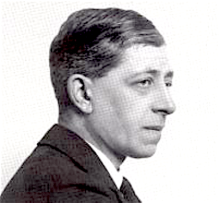
Frederick Landseer Maur Griggs [commonly known as F.L. Griggs and as F.L.B. Griggs*] was born in Hitchin, Hertfordshire, England on 30 October 1876.
He began his career as an as an architectural draughtsman first in the office of Walter Millard in Hitchin and, from 1895, with C. E. Mallows. By 1897 he had left Mallows' office and had set up a studio in Hichin. He soon made his mark with his architectural perspectives and in 1900 was commissioned by Macmillan & Co. to draw illustrations for Hertfordshire in their Highways and Byways series. He subsequently produced twelve books for the series over a period of forty years.
In 1903 Griggs moved to the Cotswold village of Chipping Campden in Gloucestershire, a hotbed of the Arts and Crafts movement, where C. R. Ashbee had located his Guild of Handicraft the previous year.
In addition to his work as an illustrator, Griggs was also an architect. He mainly worked on small-scale commissions and on restoration projects on the Cotswold area. With Norman Jewson, he designed Dover's Court in Chipping Campden, built between 1927 and 1937. He also worked with Jewson in the restoration of buildings in Chipping Campden]. Following World War One, Griggs designed a number of war memorials including at Biddenham, near Bedford, and at Chipping Campden.
In 1921 Griggs established his own press, and designed several typefaces, including Leysbourne (later renamed Littleworth)
He exhibited at the Beaux Arts Gallery, Baillie Gallery, Colnaghi & Co. Gallery, Fine Art Society, Royal Academy, Royal Society of Painter-Etchers and Engravers and Arthur Tooth & Sons Gallery in London; Royal Glasgow Institute of the Fine Arts; and at the Royal Scottish Academy in Edinburgh. He was elected a member of the Art Workers Guild in 1911; an Associate of the Royal Society of Painter-Etchers and Engravers (ARE) in 1916; a full member of the Royal Society of Painter-Etchers and Engravers (RE) in 1918; an Associate of the Royal Academy (ARA) in 1922; a member of the Royal Society of British Artists (RBSA) in 1925; and a Royal Academician in 1932. He was also an active member of the Council for the Preservation of Rural England and the Society for the Protection of Ancient Buildings.
Griggs died in London on 7 June 1938.
_____
* Prior to his conversion to Roman Catholicism in 1912, he sometimes signed his work F.L.B. Griggs
Alexander, Russell George, ‘Engraved work of F.L. Griggs’. Artwork vol. 5, no.19, 1929, supplementary pages 11-12
Alexander, Russell George. F.L. Griggs: engraved work, etchings and drypoints. Stratford-upon-Avon, England: Shakespeare Head Press, 1928
Armstrong, Barrie and Armstrong, Wendy. The Arts and Crafts movement in the North West of England: a handbook. Wetherby, England: Oblong Creative Ltd., 2006
Aslet, Clive. ‘A return to Eden’. Country Life vol. 212, no. 38, 19 September 2018 pp. 100-106. [Describes how F.L. Griggs fought to preserve Chipping Campden]
Comstock, Francis Adams. A gothic vision: F.L. Griggs and his Work. Boston, Massachusetts: Boston Public Library, 1966
Dodgson, Campbell. ‘Latest etchings of F.L. Griggs R.A.: with supplement ot the catalogue of etchings of F.L. Griggs by Rissell Alexander 1926’ Print Collector’s Quarterly vol. 28, October 1939 pp. 264-291
Gray, A. Stuart. Edwardian Architecture: a Bographical Dictionary. London: Gerald Duckworth & Co., Ltd., 1985
Lacey, Hester. ‘Revealed: a dream, a nightmare, a delight’. Cornerstone vol. 29, no. 4, 2008, pp. 48-51.
Moore, Jerrold Northrop. F.L. Griggs (1876-1938): the Architecture of Dreams. Woodbridge, Suffolk: Antique Collectors’ Club, 1999
‘Obituary’. The Builder 10 June 1938 p. 1127
‘Recent illustrated volumes’ [Review of F.L. Griggs (1876-1938): the Architecture of Dreams by Jerrold Northrop Moore (Woodbridge, Suffolk: Antique Collectors’ Club, 1999). Studies in Illustration no. 43, Winter 2009 pp. 24-26
Wright, Harold J. L. The work of F. L. Griggs : with particular reference to his etchings. Cheltemham: Cheltenham Art Gallery, 1939